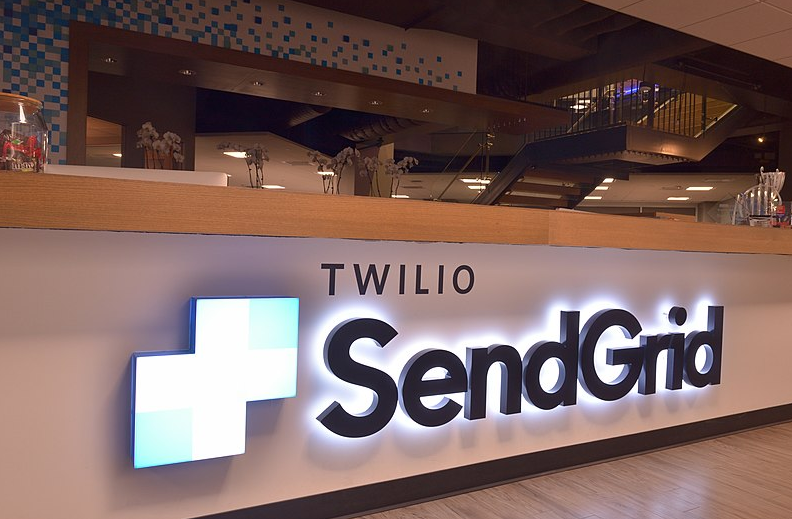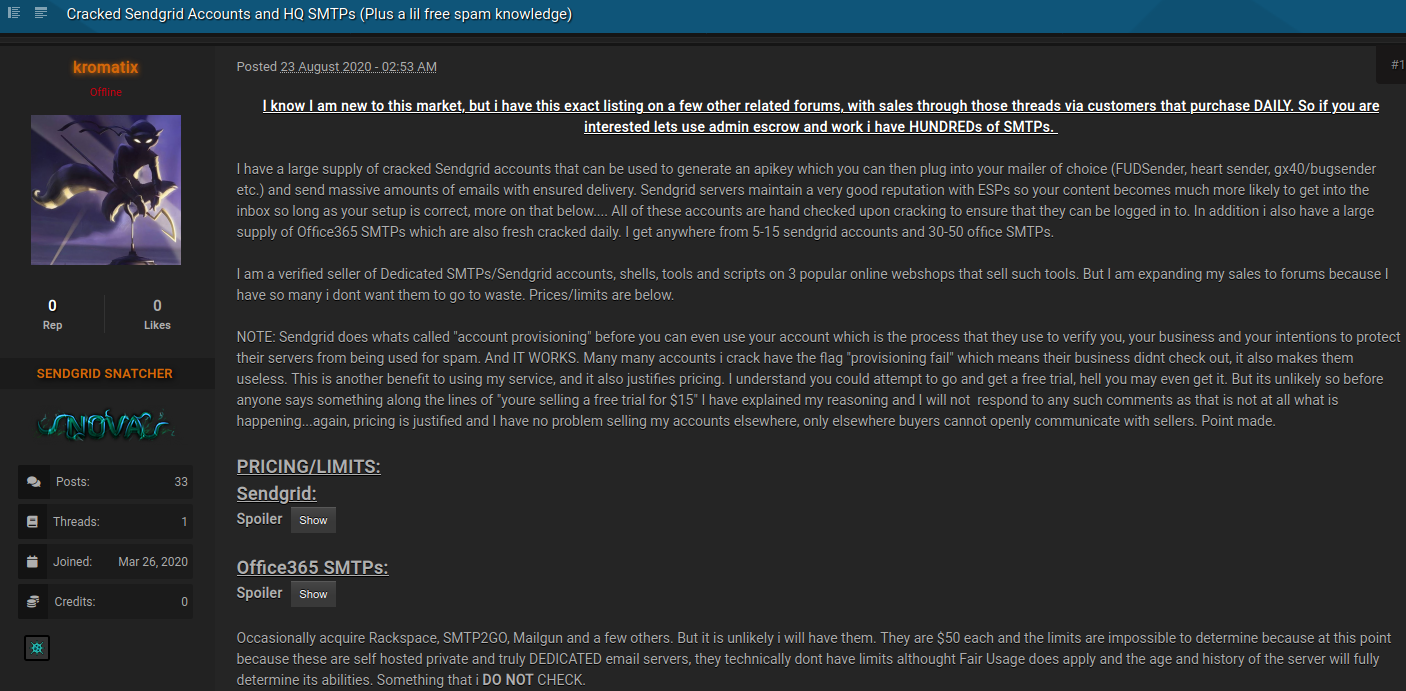Sendgrid Under Siege from Hacked Accounts
August 28 2020Email service provider Sendgrid is grappling with an unusually large number of customer accounts whose passwords have been cracked, sold to spammers, and abused for sending phishing and email malware attacks. Sendgrid’s parent company Twilio says it is working on a plan to require multi-factor authentication for all of its customers, but that solution may not come fast enough for organizations having trouble dealing with the fallout in the meantime.

Image: Wikipedia
Many companies use Sendgrid to communicate with their customers via email, or else pay marketing firms to do that on their behalf using Sendgrid’s systems. Sendgrid takes steps to validate that new customers are legitimate businesses, and that emails sent through its platform carry the proper digital signatures that other companies can use to validate that the messages have been authorized by its customers.
But this also means when a Sendgrid customer account gets hacked and used to send malware or phishing scams, the threat is particularly acute because a large number of organizations allow email from Sendgrid’s systems to sail through their spam-filtering systems.
To make matters worse, links included in emails sent through Sendgrid are obfuscated (mainly for tracking deliverability and other metrics), so it is not immediately clear to recipients where on the Internet they will be taken when they click.
Dealing with compromised customer accounts is a constant challenge for any organization doing business online today, and certainly Sendgrid is not the only email marketing platform dealing with this problem. But according to multiple emails from readers, recent threads on several anti-spam discussion lists, and interviews with people in the anti-spam community, over the past few months there has been a marked increase in malicious, phishous and outright spammy email being blasted out via Sendgrid’s servers.
Rob McEwen is CEO of Invaluement.com, an anti-spam firm whose data on junk email trends are used to improve the spam-blocking technologies deployed by several Fortune 100 companies. McEwen said no other email service provider has come close to generating the volume of spam that’s been emanating from Sendgrid accounts lately.
“As far as the nasty criminal phishes and viruses, I think there’s not even a close second in terms of how bad it’s been with Sendgrid over the past few months,” he said.
Trying to filter out bad emails coming from a major email provider that so many legitimate companies rely upon to reach their customers can be a dicey business. If you filter the emails too aggressively you end up with an unacceptable number of “false positives,” i.e., benign or even desirable emails that get flagged as spam and sent to the junk folder or blocked altogether.
But McEwen said the incidence of malicious spam coming from Sendgrid has gotten so bad that he recently launched a new anti-spam block list specifically to filter out email from Sendgrid accounts that have been known to be blasting large volumes of junk or malicious email.
“Before I implemented this in my own filtering system a week ago, I was getting three to four phone calls or stern emails a week from angry customers wondering why these malicious emails were getting through to their inboxes,” McEwen said. “And I just am not seeing anything this egregious in terms of viruses and spams from the other email service providers.”
In an interview with KrebsOnSecurity, Sendgrid parent firm Twilio acknowledged the company had recently seen an increase in compromised customer accounts being abused for spam. While Sendgrid does allow customers to use multi-factor authentication (also known as two-factor authentication or 2FA), this protection is not mandatory.
But Twilio Chief Security Officer Steve Pugh said the company is working on changes that would require customers to use some form of 2FA in addition to usernames and passwords.
“Twilio believes that requiring 2FA for customer accounts is the right thing to do, and we’re working towards that end,” Pugh said. “2FA has proven to be a powerful tool in securing communications channels. This is part of the reason we acquired Authy and created a line of account security products and services. Twilio, like other platforms, is forming a plan on how to better secure our customers’ accounts through native technologies such as Authy and additional account level controls to mitigate known attack vectors.”
Requiring customers to use some form of 2FA would go a long way toward neutralizing the underground market for compromised Sendgrid accounts, which are sold by a variety of cybercriminals who specialize in gaining access to accounts by targeting users who re-use the same passwords across multiple websites.
One such individual, who goes by the handle “Kromatix” on several forums, is currently selling access to more than 400 compromised Sendgrid user accounts. The pricing attached to each account is based on volume of email it can send in a given month. Accounts that can send up to 40,000 emails a month go for $15, whereas those capable of blasting 10 million missives a month sell for $400.
“I have a large supply of cracked Sendgrid accounts that can be used to generate an API key which you can then plug into your mailer of choice and send massive amounts of emails with ensured delivery,” Kromatix wrote in an Aug. 23 sales thread. “Sendgrid servers maintain a very good reputation with [email service providers] so your content becomes much more likely to get into the inbox so long as your setup is correct.”
Neil Schwartzman, executive director of the anti-spam group CAUCE, said Sendgrid’s 2FA plans are long overdue, noting that the company bought Authy back in 2015.
“Single-factor authentication for a company like this in 2020 is just ludicrous given the potential damage and malicious content we’re seeing,” Schwartzman said.
“I understand that it’s a task to invoke 2FA, and given the volume of customers Sendgrid has that’s something to consider because there’s going to be a lot of customer overhead involved,” he continued. “But it’s not like your bank, social media account, email and plenty of other places online don’t already insist on it.”
Schwartzman said if Twilio doesn’t act quickly enough to fix the problem on its end, the major email providers of the world (think Google, Microsoft and Apple) — and their various machine-learning anti-spam algorithms — may do it for them.
“There is a tipping point after which receiving firms start to lose patience and start more aggressively filter this stuff,” he said. “If seeing a Sendgrid email according to machine learning becomes a sign of abuse, trust me the machines will make the decisions even if the people don’t.”





